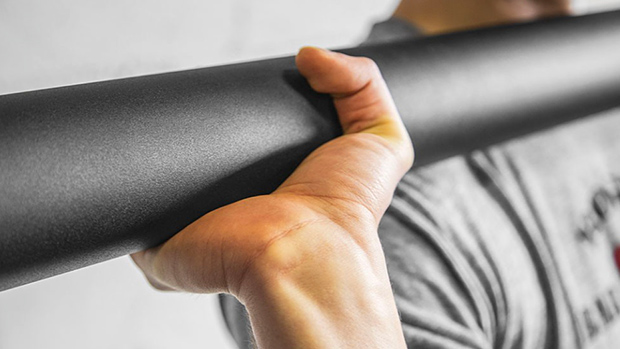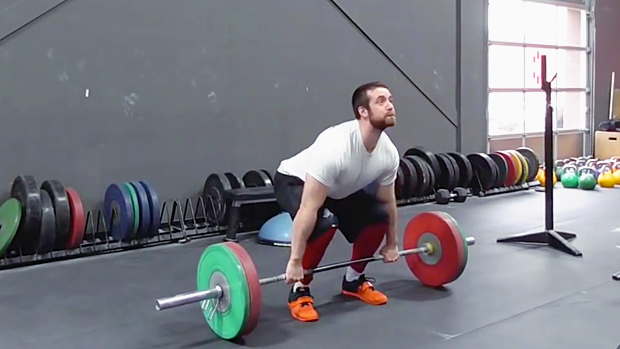Why is it that common sense drops right through the porcelain fixture when lifters plan their grip training? If you're only going to perform a few barbell wrist curls at the end of a workout and expect vein-popping forearm muscles, you're sadly mistaken!
I know guys who research and plan the parameters of their chest and back routines like Einstein analyzing relativity, but when it comes to grip training, they make about as much sense as a frat boy who just bumped into Pamela Anderson after getting "pissed" on beers at an Australian pub.
Growing up in the hillbilly country of Midwest USA taught me a lot about grip strength. Back when I started working out at age 14, I didn't have access to any of that "high-tech" city-boy equipment like wrist wraps and cable pulley systems. Instead, I had to do all of my lifting raw (i.e., no lifting aids).
When I performed deadlifts, I had to use my own grip strength to hold the load. When I performed chin-ups in the garage on a wooden beam, my grip would inevitably give out before my back and biceps. But, after a short period of time, my grip was able to compete with my back and biceps strength. During the summer I bailed hay and worked with my buddy on a farm. This is the best thing that I could ever have done to improve my grip and forearm strength. So by default, I built a set of forearms that not only looked great, but performed awesome as well. You can too, city-boy, if you read on.
First of all, I want you to quit your pansy city job and move to a farm. Nahh, I'm just kidding. First, we need to remember what it takes to get strong. According to famed strength researcher Vladimir Zatsiorsky, there are three ways to build strength:
- Lift a maximal load, which is known as the Maximal Effort Method.
- Lift a submaximal load as explosively as possible, which is known as the Dynamic Effort Method.
- Lift a submaximal load to failure, which is known as the Repeated Effort Method.
Therefore, in order to build a world-class grip, we need to execute all three methods. Most people only do one of the above methods, such as opening and closing one of those worthless plastic grippers for a million reps (a perverse example of the repeated effort method) – a method that wouldn't even challenge my grandma. Those grippers provide about 30 lbs of resistance when closed and do little more than pump up your puny forearms. Never fret, after applying my techniques you will want to wear a short-sleeved shirt all the time, even in northern Siberia during the winter! But let me first dispel some myths.
1. You Must Perform High Reps Every Day
This myth falls along the same lines as the 1980's abdominal training advice. The problem is this; if you train with high repetitions every day, you're only challenging the Type I slow-twitch muscles to grow. Anyone with half a brain knows you must tap into the higher threshold Type-II motor units, especially the Type-II b, which have the highest potential for growth and maximal strength development. So ditch the high-repetition, everyday training 'cause it will get you nowhere!
2. Grippers are The Best Exercise for Forearm Development
I could give so many examples of why this isn't true but I'll focus on one from my own experience. I spent most of my weekends on a farm where my buddy "Tater" lived. His dad Bill was a farmer and mechanic. Bill had never stepped inside a weight-room and he didn't even know what a hand-gripper was, but he had a humungous pair of forearms that even Popeye would envy.
Bill spent his day lifting heavy farm objects, turning huge wrenches, twisting screwdrivers and carrying heavy buckets – just to name a few activities. So you ask,
"Yeah, they looked good, but were they strong?" Let me answer that question by getting back to Tater.
One day ol' Tater put a dent in the family truck by accidentally sliding it into the ditch on a snowy day. Bill wasn't too happy. He grabbed Tater by the neck and picked him up off the ground (that's about 300 lbs of Tater) with one hand! Now that's what I call functional strength.
In other words, strong forearms require varying types of work.
3. Bodybuilders have Strong Forearms
If you constantly perform high-volume training for the forearm muscles, they'll hypertrophy. The problem is that this type of training would constitute sarcoplasmic hypertrophy, not the strong functional sarcomere hypertrophy of the muscle fibers. You must hypertrophy the actual muscle fibers, not the extracellular space, if you want the awesome look of your forearms to carry over into real-world strength.
Also, bodybuilders constantly use wrist straps when performing everything from deadlifts to pulldowns. What's the point of lifting a load you can't hang on to? In my opinion, if you can't pull 600 lbs off the floor without straps, then you can't pull 600 lbs!
Now that we've dispelled some myths, let's get back to the strength development guidelines. As stated above, we must do three different types of training. Here they are, in table format, with their defined load percentages, sets, reps, and characteristic tempos:
| Method | Load | Sets | Reps | Tempo |
|---|---|---|---|---|
| Maximal Effort | 95-100%1RM | 3-5 | 1-3 | 30X0 |
| Dynamic Effort | 55-65%1RM | 6-10 | 2-4 | 10X0 |
| Repeated Effort | 75-85%1RM | 4-6 | 4-8 | 3020 |
I recommend using one method exclusively before resting 3-5 days and then incorporating the next method. In other words, on day one, do your exercise or exercises using the Maximal Effort technique. On day two, 3-5 days later, do your exercise or exercises using the Dynamic Effort technique. Then, on day three, 3-5 days later, do your movement or movements using the Repeated Effort technique.
Do this "cycle" three times before choosing new exercises, one from each category of forearm exercises that follows. You can do this pretty much continually, choosing new movements every time you complete 3 cycles, until you have huge forearms, or until they carry you out to the farm and plant you in the corn field.
Here's an example of a cycle:
| Day | Method | Exercise | Sets | Reps |
|---|---|---|---|---|
| Monday | Maximal | Fat Grip Barbell lifts | 3-5 | 1-3 |
| Friday | Dynamic | Band Extensions | 6-10 | 2-4 |
| Tuesday | Repeated | Alligator Smash | 4-6 | 4-8 |
Again, perform this sequence for three cycles before switching exercises.
The incredible Westside Barbell Club combines two of the above methods into each workout. For the purposes of forearm strength, I want to keep the methods separate since combining them would constitute excessive volume (assuming you are performing exercises outside this routine that also tax the gripping muscles).
Now let's get to the real good stuff – exercises. You'll never develop a world-class grip if you waste your time with plastic grippers and wrist curls. The hand and forearm muscles have the potential to perform many different movement patterns so don't limit yourself to those two movements. So here's how you do it (remember, you'll be choosing one exercise from each of the following 3 categories to formulate your training cycle):
This seems so simple to me but I'd have to say the extensors are the most neglected variable in grip training. The hand and forearm extensors must be trained for developing maximal grip strength. You wouldn't just train the biceps and leave out the triceps would you? I didn't think so. Remember, the body will limit absolute strength potential if the antagonist is weak in order to protect the joint. Therefore, train the extensors of the hand/wrist and prepare to be amazed. Here are some great exercises for this purpose:
Finger Band Extensions
Get a rubber band (not the skinny cheap ones, the fatter version they use in post offices) and place your fingers inside the band. Spread your fingers as wide as possible without the rubber band rolling down your fingertips and then close them. Another method involves just placing the band between two metacarpals (i.e., fingers) and doing the same thing.
Increase resistance by adding more rubber bands on top of each other. This is also an excellent exercise for anyone with wrist or carpal tunnel problems. Adding this exercise to your routine will frequently diminish any symptoms. If you get too strong for the rubber bands, you could also purchase a finger extension band from a sports equipment store. Use this exercise for any of the three methods.
Sand Extensions
Get a five-gallon bucket and fill it with sand. With your fingers straight and closed tight together, thrust your hand into a bucket of sand. Next, spread your fingers apart as quickly as possible. Remove hand and repeat. Depending on your strength levels this could be a maximal effort movement (if you're weak) or a dynamic/repeated effort method (if you're stronger).
As a side note, sand isn't the only substance you can use. I guess you could stick your hand in pebbles, mud or a big pot of Aunt Bessie's Oatmeal if you feel so inclined. (If you're worried about your manicure right now, then you're reading the wrong article!)
Plate Pinch Extensions
Grab a light plate (10 lb or so) and hold it with a pronated (palm down) wrist position. Your fingers should be on one side and your thumb on the other. While holding your arm straight out in front, flex and extend your wrist joint for the recommended number of reps. As your strength increases, add more plates so you're pinching them together with the smooth side out. Until your grip strength develops, use this exercise for the repeated and dynamic effort methods.
For those of you who train raw and use your own grip strength for movements like deadlifts and chin-ups, great, but you also need to lift objects when your fingers are more open (i.e., extended). Here are some great exercises for this purpose:
One-Hand Upright Dumbbell Lifts
Stand a dumbbell up on end (so it makes an "I" shape if you look at it from the side). Position yourself so you're standing over the dumbbell with your legs apart. Grab the top of it with your hand like you're picking a softball up off the ground and lift it up to waist level. Lower and repeat.
For a more advanced version, lift it to chest level. I must warn you not to use a dumbbell that opens your fingers any further than 80% of total extension. In other words, keep a slight flex in your hand or you could overly strain the structures of the wrist and hand. Either a dumbbell with hex or smooth ends will work.
Fat Grip Barbell Deadlifts
Buy a pair of EZ grips or wrap a towel around the center of the barbell so that the diameter of the bar is between 2.5 and 3 inches. Since a towel will smash together, initially, it needs to be much thicker than 2.5-3 inches in order to get the right grip. (An even better method would involve making your own fat grip bar at home by placing a 2.5-3 inch piece of pipe around the bar and welding it together.)
Load a small plate (10 or 25 pounds) on each end of the bar. As with any new exercise, it is best to start with a light load instead of injuring yourself on the first rep. Place the barbell in front of you, grab it in the middle with your right arm, and perform a traditional deadlift. Lift and lower 1-3 times before switching to the left hand.
You could also place the bar next to you on the ground and perform the same movement. I know many of you are thinking a dumbbell would work just as well. Trust me, it doesn't because it requires a lot more muscle action to keep a barbell parallel to the ground. This is a great exercise for the maximal effort method.
One Arm Wheelbarrow Walks
This is truly an advanced exercise I came up with (well, maybe someone else is doing it, too, but I don't know about it). Get a small, unloaded wheelbarrow. Grab the handles as you normally would (semi-supinated grip) and begin to walk with it. Easy so far, huh? Here comes the tough part – slowly pull the left hand off the end of the left handle one finger at a time (the pinky comes off first).
Keep sliding the left hand off while still maintaining balance with the right hand. The wheelbarrow must be kept perfectly level or it won't work. Initially, you'll probably only get a few fingers off, but keep at it. Push the wheelbarrow for approximately 30 seconds before switching hands. Maybe someday you'll be in the elite group and push it with one hand. Talk about grip strength!
So far, we've hit the extensors of the hand and forearm along with isometric muscle action. Now we need to do some dynamic training for the flexors. Here are some great exercises:
Captain of Crush Gripper
Purchase one of these grippers from Ironmind.com. Depending on your strength level you could use anywhere from a Trainer (100 lbs resistance) to the mighty No. 4 (365 lbs resistance). Use a gripper that allows you to perform the recommended rep ranges for dynamic and repeated effort methods. If you're unsure of your strength, purchase the No. 1 gripper. Slam the gripper shut using explosive action for the dynamic method or moderate muscular action for the repeated effort method. Depending on your strength level, you might need to use the Trainer for the maximal effort day.
Sand Grabbing
I learned this exercise from John Brookfield's excellent book "Mastery of Hand Strength." Thrust your hand into a 5-gallon bucket of sand, pebbles, steel shot or any other resistive substance and grab a handful as explosively as possible. Remove hand and repeat. Those of you who want to be less "rugged" can use a pair of thin gloves. Use this exercise for the dynamic or repeated effort method.
Alligator Smash
Find a piece of foam; a mattress; a seat cushion or anything else that fits your hand. Place hand so fingers are straight (extended) on one side and the thumb is on the other. Smash fingers and thumb together (if you can't picture this, imagine your hand was in a sock making a puppet and you were making the puppet's mouth move). Use this exercise for any of the three strength methods.
If you're having a difficult time developing strength and/or size on one side relative to the other, you may have a nerve problem in the C6-T1 area of the spine. Check with a reputable chiropractor for an accurate diagnosis. Another possible cause could be adhesions on or between the forearm and hand muscles. Frequently, we abuse our gripping muscles with repetitive trauma throughout the day. This problem can be easily treated by an Active Release Technique practitioner.
Incorporating this information with the guidelines in "Get a Grip" will build a world-class grip that is both aesthetically pleasing and extremely functional and strong. So if that dude from the old Charles Atlas ad comes up to you on the beach, kicks sand in your face and tries to take your girl – you can grip his neck with one hand and practice your Alligator Smash movement by pretending he's a sock puppet!





